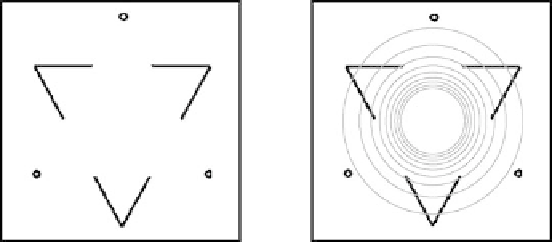Biomedical Engineering Reference
In-Depth Information
Figure 11.20: Image with subjective contours: double-Kanizsa triangle (left),
and image together with isolines of initial segmentation function (right) (color
slide).
can be used to speed up computations. Our choice of peak-like initial function is
motivated by its nearly flat profile near the boundary of computational domain.
However, other choices, e.g.,
u
0
(
x
)
=
1
−
|
x
−
s
R
, are also possible. If we put the
focus point
s
not too far from the center of mass of the segmented object,
we get only slightly different evolution of the segmentation function and same
segmentation result.
Now we will discuss some further segmentation examples. In Fig. 11.20 we
present image (234
×
227 pixels) with subjective contours of the classic triangle
of Kanizsa. The phenomenon of contours that appear in the absence of physi-
cal gradients has attracted considerable interest among psychologists and com-
puter vision scientists. Psychologists suggested a number of images that strongly
require image completion to detect the objects. In Fig. 11.20 (left), two solid tri-
angles appear to have well defined contours, even in completely homogeneous
areas. Kanizsa called the contours without gradient “subjective contours” [29],
because the missed boundaries are provided by the visual system of the subject.
We apply our algorithm in order to extract the solid triangle and complete the
boundaries. In Figs. 11.21 and 11.22 we present evolution of the segmentation
function together with plots of level lines accumulating along edges and closing
subjective contours areas. In this experiment we used
ε
=
10
−
5
,
K
=
1,
v
=
0
.
5,
τ
=
0
.
001, TOL
=
10
−
3
. For long time periods (from 60th to 300th time step)
we can also easily detect subjective contours of the second triangle. The first
one, given by closing of the solid interrupted lines, is presented in Fig. 11.22
(bottom), visualizing level line (min(
u
)
+
max(
u
))
/
2. Interestingly, for bigger
ε
the second triangle has not been detected.

